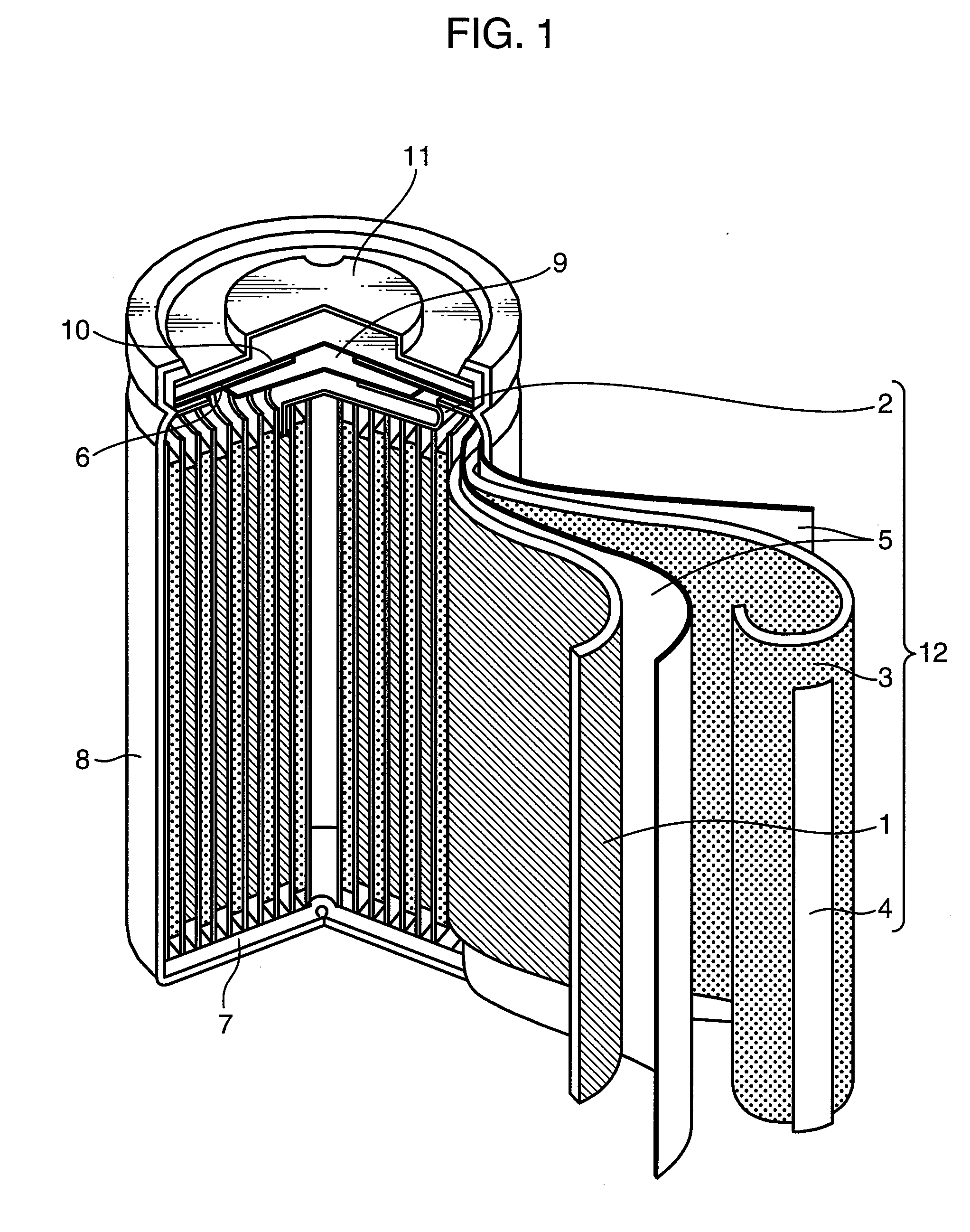Nonaqueous electrolyte secondary battery
a secondary battery and electrolyte technology, applied in the direction of non-aqueous electrolyte cells, cell components, sustainable manufacturing/processing, etc., can solve the problems of increasing the impedance of the negative electrode, clogging the separator, and electrolyte secondary batteries were thus unsatisfactory in high-temperature storage stability, etc., to achieve high polymerization degree, high polymerization reactivity, the effect of raising the resistan
- Summary
- Abstract
- Description
- Claims
- Application Information
AI Technical Summary
Benefits of technology
Problems solved by technology
Method used
Image
Examples
example 1
Positive Electrode
[0079]10 parts by mass of a conductive substance acetylene black and 5 parts by mass of a binder polyvinylidene fluoride resin were mixed with 85 parts by mass of lithium cobaltate (LiCoO2) powder, and the mixture was dispersed in dehydrated N-methyl-2-pyrrolidone (dehydrated NMP), to give a positive electrode mixture slurry. The positive electrode mixture was coated on a positive-electrode current collector of aluminum foil; the foil was, after drying, rolled, to give a sheet-shaped positive electrode having the positive-electrode active material layer laminated.
(Negative Electrode)
[0080]1 part by mass of a binder polyethylene resin and 1 part by mass of a thickener carboxymethylcellulose were mixed with 100 parts by mass to a man-made graphite powder; and the mixture was dispersed in water, to give a negative-electrode mixture slurry. The negative electrode mixture was coated on a negative-electrode current collector of copper foil, and the foil is, after drying,...
example 2
[0096]Example 2 was carried out similarly to Example 1, except that a polyamide separator was used instead of forming a porous protective film on the surface of the negative-electrode active material layer.
example 3
[0102]Example 3 is carried out similarly to Example 1-1, except that the separator shown in Table 3 was used instead of forming a porous protective film on the surface of the negative-electrode active material layer. Example 3-7 is the same as Example 2-1. The samples of Example 3 were also evaluated. Results are summarized in Table 3.
[0103]The abbreviations used in Table 3 are the followings:
PTFE: polytetrafluoroethylene
PFA: tetrafluoroethylene-perfluoroalkyl vinylether copolymer
FEP: tetrafluoroethylene-hexafluoropropylene copolymer
ETFE: tetrafluoroethylene-ethylene copolymer
PVDF: polyvinylidene fluoride
PCTFE: polychloro-trifluoroethylene
PA: polyamide
PI: polyimide
PAI: polyamide-imide
PEI: polyether imide
PAR: polyarylate
PSF: polysulfone
PES: polyether sulfone
PPS: polyphenylene sulfide
PEEK: polyether ether ketone
PET: polyethylene terephthalate
PBT: polybutylene terephthalate
PPE: polyphenylene ether
POM: polyoxymethylene
PS: polystyrene
ASA: acrylonitrile-styrene-acrylate terpolymer
Alumina-...
PUM
| Property | Measurement | Unit |
|---|---|---|
| temperature | aaaaa | aaaaa |
| temperature | aaaaa | aaaaa |
| thickness | aaaaa | aaaaa |
Abstract
Description
Claims
Application Information
 Login to View More
Login to View More - R&D
- Intellectual Property
- Life Sciences
- Materials
- Tech Scout
- Unparalleled Data Quality
- Higher Quality Content
- 60% Fewer Hallucinations
Browse by: Latest US Patents, China's latest patents, Technical Efficacy Thesaurus, Application Domain, Technology Topic, Popular Technical Reports.
© 2025 PatSnap. All rights reserved.Legal|Privacy policy|Modern Slavery Act Transparency Statement|Sitemap|About US| Contact US: help@patsnap.com


